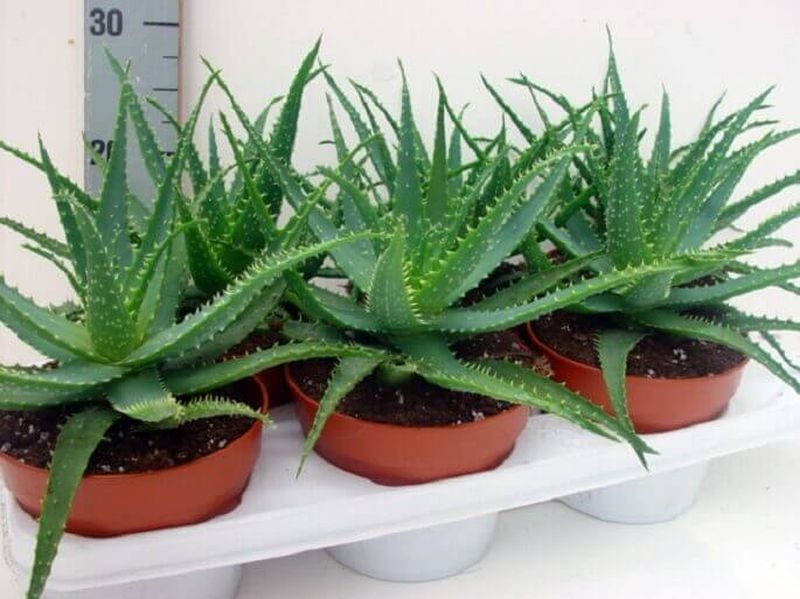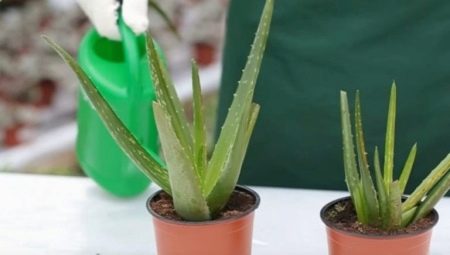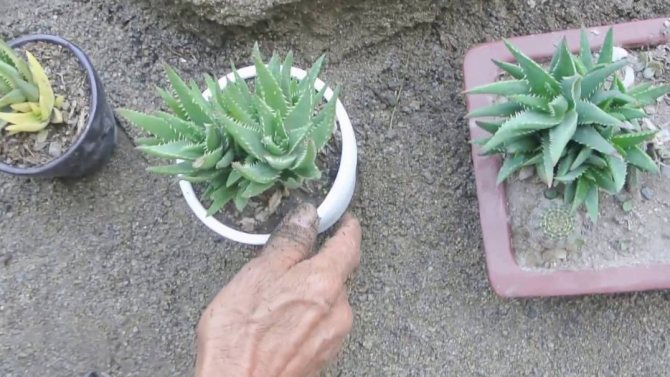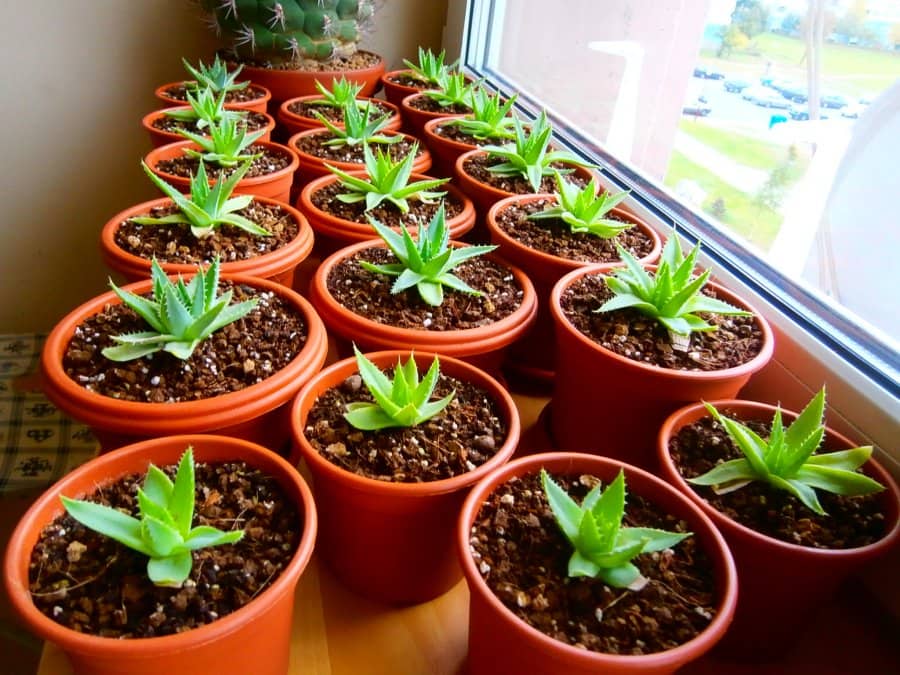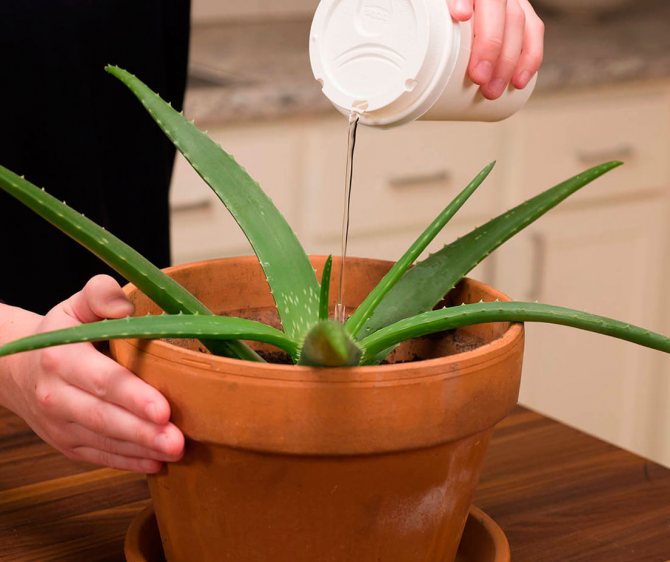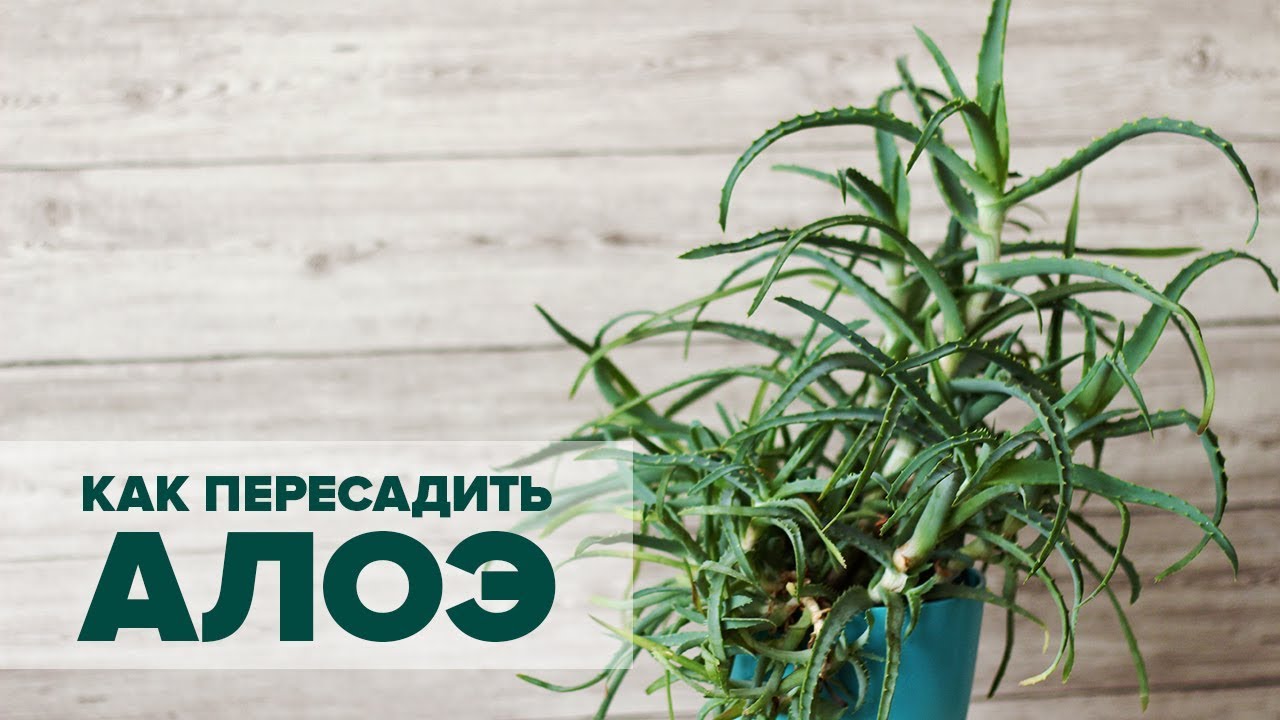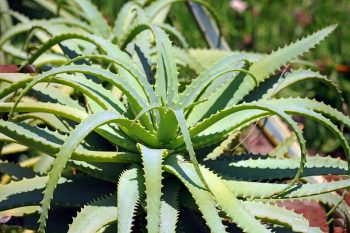Aloe transplant rules
You need to know how to properly transplant aloe so that the plant feels comfortable. To do this, take into account the size of the plant, its age and other nuances.
How to transplant an adult plant into another pot?
A novice owner should familiarize himself with the rules on how to transplant aloe into another pot so that it quickly takes root. To begin with, choose a suitable pot and prepare the substrate. If the rhizome grows to the sides, you will need a wider container, if down - deep. Next, you need to follow a few simple steps:
- pour a small earthen pillow into a new pot;
- carefully remove the plant from the old container, being careful not to damage the roots;
- place it in a new pot and add soil on the sides.
You may need to add some soil after a few days when it is compacted. In a new container, the plant is left in the shade for a week, watered only after 5 days. Then he is transferred to a well-lit windowsill or balcony.
How to separate and transplant the process?
The most common way of propagation of aloe is by shoots, or by children. They appear every year under the mother bush and already have their own roots. You need to know a few nuances of how to transplant an aloe process so as not to harm an adult plant:
- a small bush is carefully dug out of the ground so as not to damage the roots;
- immediately transplant it into a separate pot;
- the plant is watered moderately every few days.
This is the easiest way to transplant aloe. In this way, the plant can reproduce all year round, but it is better to wait for the warm season. This plant can form a large number of babies per season. Many owners complain that their flowers multiply too intensively, and their pots occupy all the free surfaces.
Transplant by cuttings
Aloe can be propagated by cuttings. They are shoots that extend from the main stem. The procedure is simple and can be carried out at any time of the year:
- the appendix is cut with a knife as close to its base as possible;
- the cut must be dried before planting, so the sprout is left in the shade for 5 days;
- without waiting for the roots to appear, the cutting must be planted in the ground to a depth of several centimeters;
- the plant is watered immediately after planting, and then when it takes root.
Recommended: Aloe Vera and Centenary - Benefits and Differences
You can plant several cuttings at the same time in one large container. In this case, the distance between flowers should be at least 5 cm.
Transplant without root
If the flower grows too tall, you can cut off the top and form a separate plant. The lower leaves are immediately used to obtain juice or gel, which are then added to cosmetics and medicines. The transplant procedure is very simple:
- the top with 6-7 leaves is cut with a knife;
- the shoot is placed in a jar of water and waited for it to take root;
- the plant is planted in a pot with a suitable substrate.
The method for transplanting aloe without a root is suitable for large adult plants. The leaves become suitable for medicinal purposes for 3-4 years of life, then they are cut off. As a result, the flower turns out to be tall, and the leaves are only at its top.
Transplant methods
Aloe multiplies easily:
- Transplant of a part of an adult color;
- Jigging the appendix;
- Parts of green leaves;
- Seeds.
Each method has some small tricks.
Transplanting an adult plant
You need to transplant the old aloe in the following cases: Buying a flower in a store. If the flower has "outgrown" the size of the pot. Diseases or pests have appeared in the ground. Stages of transplanting a whole plant:
- Watered for a day or two before transplanting.
- Free from the old container. The earth is shaken off slightly, old rotten roots are removed. If the transplant is caused by the presence of pests or diseases, the roots are washed from the ground completely.
- 2-3 cm of finished soil is poured onto the drainage layer.
- The plant is placed in the center of the pot. The roots should not be bent. The stem is placed 2-3 cm below the edge of the planting container.
- The roots are evenly covered with earth, lightly tamping.
- Watering is carried out strictly at the root. Moisture should not get on the rosettes of the leaves and cause rotting of the weak plant after transplanting.
- Protect from direct sunlight for 3-5 days.
Separation and deposition of the appendix
Shoots grown from the root are suitable for jigging. You can plant a baby aloe when a small plant has reached 5-10 cm in growth and has released 3-4 leaves. There are two ways to take a scion from an aloe:
The plant is removed from the pot, shaken off the ground. In this case, with a sharp knife, it is easy to separate all the processes along with the roots and an adult plant.
Small plants are transplanted into separate pots or into a "school" for growing.
The shoots are carefully separated with a narrow spatula, trying not to damage the roots. An adult flower is not taken out, leaving it to grow in the same place.
Without root
Aloe is successfully propagated by plant parts without roots:
- Cuttings;
- Leaves;
- The tops of lignified stems
Aloe cuttings are young shoots that have grown on the base, lateral stem or top of plants.
Cuttings or parts of leaves are cut with a sharp knife closer to the mother plant. After processing the cut site with activated carbon, the planting material is removed to a dark, cool place for wound healing. A leaf or stalk is planted in wet washed sand. In two weeks, the roots will appear.
After the plant has come to life, it has begun to grow, it is transplanted to a permanent place. A new plant is obtained by the “rootless” method from the tops of “wooden” stems. To do this, cut off the "crown" 2-3 cm below the leaves. The cut part is placed in a container with water. After the roots appear, the top is transplanted into a pot with earth.
Preparation
Rooting a plant at home will require preliminary preparation of containers for planting. Its size should be selected depending on the age of the culture: for a young flower you need a large pot, for aloe with sprouts, you can only replace the soil, and also plant the "kids" in separate pots.
For cultivation of succulents, it is recommended to use a plastic or ceramic container. In polymer pots, the plant will develop evenly, but in such a container it is necessary to ensure that moisture does not stagnate. As for ceramic pots, this material is able to pass air, which will contribute to the natural evaporation of excess moisture, as well as normalization of the temperature. Thus, it will be easier for the grower to take care of his plant in the future.
Before rooting the culture into the purchased container, it must be well washed and dried.

The correct preparation of the soil for the culture will help reduce stress for the plant; it is worth rooting aloe in a substrate that is as close as possible in composition to the old soil. The soil can be purchased in the store or you can cook it yourself. In the first case, the substrate should be designed for growing succulents and cacti. If you plan to prepare the soil yourself, then in this matter, you should adhere to certain recommendations. The land should be:
- nutritious and light;
- with neutral acidity.


There are several options for preparing the substrate at home:
- the soil can consist of sand, leafy and clayey sod land, taken in equal proportions, with the addition of half of the peat;
- sheet soil, coarse sand and charcoal.
In addition to the pot and soil mixture, the culture itself must also be prepared for transplanting.In this case, a few days before the planned rooting of the plant in a new place, it must be well moistened. This will make it easier and with minimal damage to later remove the aloe from the old pot.
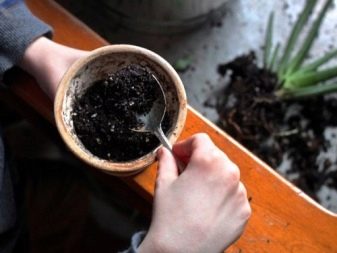
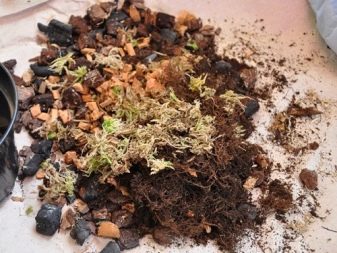
About the need for a transplant or who needs it
Aloe roots develop slowly, but the transplant cannot be delayed. There is such a thing as the removal of nutrients from the soil by a plant. The removal rate of minerals in aloe is high, which cannot be said about nitrogen, which a desert inhabitant needs little. The introduction of fertilizers will not correct the situation: the humic component of the soil is lost, the enzyme, which cannot be replenished. The soil becomes light, like dust, after watering it is taken in by a crust. Yes, and the rod-shaped root grows up, and the lobules begin to bulge out of the pot. It's time to fix the situation urgently: transplant aloe, change the soil mixture.
Transplant time - spring or summer. If the roots have grown insignificantly or a bulky plant is problematic to transplant, just replace a part of the land.

Requirements for soil mixture
The soil should be light and loose, allowing the roots to gain access to air. In terms of composition, it is a mixture of clay - sod soil and forest deciduous soil with sand in equal proportions. The addition of charcoal or peat mixture should not exceed a fifth of the soil.

At the bottom of the pot, small stones are placed for the drainage layer, which help to remove excess moisture from the flowerpot. These are fine gravel, sea pebbles, expanded clay, sawdust.
Transplant instructions step by step:
- on the eve of transplantation, the flower is watered abundantly for easy release from a cramped pot and separation of the earth depleted with salts from the root system;
- the agave is carefully removed from the flowerpot, tilting over the prepared place on the table for crumbling soil and further dividing the bush into individual plants;
- fragile fleshy leaves require careful handling during planting in a new place for further growth;
- the soil around the root system should be kept lumpy, contributing to faster rooting in a new place;
- inspection of the roots is carried out, rotten plants are removed and the plants are sorted according to the size of suitable flowerpots for each succulent;
- prepare a drainage layer along the bottom with a thickness of 5 to 10 cm, depending on the size of the new pot, consisting of fine gravel, sawdust.
- the separated aloe is placed on a small layer of soil mixture and covered with prepared soil to the edges of the flowerpot, slightly compacting the moistened soil;
- to retain moisture before rooting aloe, the top layer of the earth is laid out with a layer of expanded clay stones;
- after transplanting, the succulent is removed to a shaded place for several days without watering.
Further care of the flower
The plant moves for a week or two in partial shade. In the shaded position, the flower heals injuries, gets used to new conditions. Injuries during transplanting are always inevitable, even if the plant is transplanted very carefully.
Location and lighting
The plant needs a significant amount of sunlight. In the springtime, it is necessary for the aloe to get used to the intense sunlight. At lunchtime, it is enough to hang a small screen on the window. This technique avoids burns.
Aloe on a sunny windowsill
Important! In summer, during very intense heat, the plant must be hidden from the sun. It is good if in summer aloe grows on a balcony or terrace.
In these conditions, it must be hidden from the rain. Excess moisture contributes to the fact that the flower will rot
It is good if the aloe grows on the balcony or terrace in the summer. In these conditions, it must be hidden from the rain. Excess moisture contributes to the fact that the flower will rot.
In the fall, with a decrease in daylight hours, aloe needs additional lighting. A fluorescent lamp is suitable for this. It must be turned on as soon as the sun is hidden behind the horizon.
Temperature
The optimum temperature should not be higher than 30 degrees. In winter, you need to ensure that it does not fall less than 12 degrees. Aloe does not withstand frost, therefore, a sharp drop in temperature in winter rooms should not be allowed.
Humidity
The plant tolerates dry indoor air well. Nevertheless, if dryness is combined with an elevated temperature, it should be watered more often and sprayed periodically. In winter, when the central heating is on, use a humidifier or place small containers of water near the pot.
The plant should not be allowed to develop in rooms with dampness. The root system and stems will suffer from this.
Watering
Watering is highly dependent on the ambient temperature. If in summer the temperature reaches 30 degrees, then the plant needs to be watered every other day, sometimes daily. In the cold season, the temperature can drop to 12 degrees, in which case the aloe is watered once a week.
When growing, the soil is watered under the root, and not from above. Water that gets on the leaf rosette causes stem rot. The main criterion for the need for watering is the complete drying out of the soil.
An adult plant is fed no more than once every 3 weeks. The best will be a special fertilizer for the cactus.
The soil
It is necessary to monitor the condition of the soil. If it turns sour, the bush urgently needs to be transplanted. You need to purchase the substrate in flower shops - there are kits here specially designed for succulent plants.
Important! Aloe needs the soil to always be loosened
Loosening should be done carefully so as not to damage the roots.
If the plant does not take root
There are several reasons why the plant does not take root:
- Unsuitable soil composition. It is urgent to replace it or prepare a mixture with the correct ratio of components. The best option is to buy a ready-made mixture for succulent species.
- Poor quality planting material when transplanted by cuttings. This happens if the cutting is taken from a large plant. In this case, the agave needs to be replanted again.
- Improper care. It is necessary to very carefully follow the recommendations of flower growers and eliminate even the smallest signs of the disease in time.
Diseases, pests
Arennial can be affected by dry or gray rot. Diseases are manifested by drying or deformation of the leaves, rotting of the roots. If these signs are found, the agave needs to be urgently transplanted.
Aloe can be affected by such pests:
- Spider mite. It is difficult to notice it due to its small size. The main sign is that the thinnest cobweb appears on the leaves. The leaves turn pale and dry. At a later stage of the development of the disease, they become scarlet.
- The scale insect inhibits the process of photosynthesis. Red spots appear on the leaves.
- A sign of a mealybug is the coating of leaves with bloom.
You can fight pests with the help of special antiparasitic drugs.
Aloe is an unpretentious, beautiful and useful plant. If you follow the care, you will never have a problem with it. Its longevity will depend on the correct transplant.
When is the best time to do it?
The best period for rooting aloe in a new container will be spring, it is important to choose the right time so that the plant only leaves the dormant phase and has not yet begun to actively develop. If you manage to transplant a succulent plant during this period, then the active metabolism accompanying the growing season will help the culture to quickly adapt to new conditions and maintain its health.
This is especially true for the root system, which in any case will be disturbed and injured in the process of removing the plant from the old soil and rooting in a new container. Some growers perform aloe transplant in the summer, while propagating the culture.
It would be more correct to refrain from such work in the autumn and winter period, since at this time the succulent will already suffer from a lack of sunlight, which will weaken its immunity. In addition, the autumn-winter period is a dormant phase for aloe. As a result, the flower will take much longer to adapt to new conditions.

Breeding aloe at home
Due to the unpretentiousness of the agave, it can be easily bred at home in any quantity. It reproduces with the help of:
- children (young bushes that grow next to an adult);
- parts of the stem;
- pieces of leaf;
- seeds.
Reproduction using an offshoot (children) is perhaps the easiest and fastest way. An adult aloe bush, developing, gives a large number of young shoots that grow near it and represent a fully formed plant, with a root system and leaves. A significant number of babies in a pot with a mother flower dulls its growth.
Therefore, they just need to be removed periodically. Therefore, the use of this method of reproduction is indicated for the favorable growth of an adult agave. The harvested babies are immediately ready for planting in an individual pot. It should be noted that before removing the shoot, the soil must be watered abundantly so as not to damage the young roots during transplantation. In the pot, a drainage layer and soil are placed. The process should be deepened into the soil to the lower leaves. The soil is lightly pressed down and watered. In the future, caring for a young agave is the same as for an adult. The plant quickly and well takes root in a new place.
It is also easy to grow an agave without roots using the top of the stem
In this case, it is important to properly prepare the cutting. For these purposes, use the upper part of the stem with at least two leaves. After the stalk is cut from the main bush, it needs to be given time to rest.
Within a week, the cut sites should dry out a little. All this time, the cutting can be stored in a paper towel at room temperature or on the bottom shelf of the refrigerator. After the stalk, you need to plant it in the ground, adhering to the planting principles indicated when considering aloe by children. Since grafting is a way of growing an agave without roots, to improve the survival rate of a part of the stem, it is covered with a glass jar. In conditions of constant temperature and humidity, the cutting quickly forms a root system and takes root. Just remember that this method of growing requires daily care: airing, watering. When young leaves appear on the surface of the soil, the jar can be completely removed, the agave is perfectly rooted and began to grow.
Regarding whether cut stems can take root in a glass of water, the opinion of flower growers is diametrically opposed. Some strongly recommend that before planting the cutting, soak it in water until it takes root. Others insist that the stems rot when they are in water for a long time and are best planted immediately in the ground.
Therefore, the right to choose how to root the stalk remains with the florist, in any case, if one of the chosen methods turns out to be less effective, then the rapid reproduction of the agave will allow reproduction to be repeated without damage to the population.
The next way to propagate aloe is with a leaf. Of course, this will take a little longer, but this is an ideal opportunity to get a full-grown plant when there are no shoots or cuttings.
First of all, a leaf with a length of 3-5 centimeters is cut off. It is dried within a week, that is, put on a paper napkin so that the cut site is slightly tightened with a protective film. Then the sheet must be planted in the ground from the ground - 1 part and sand - 2 parts, watered and covered with glass or a jar.Greenhouse conditions help the leaf to form roots faster. As soon as young shoots appear, the plant can be planted in an individual pot with soil.
Growing aloe from seeds at home is extremely rare. This is a rather laborious process and is resorted to when they decide to grow their own decorative variegated species of this plant. Seeds for planting are purchased in the store, where you can also get detailed instructions on how to grow them correctly. In general terms, we denote that before sowing, the planting material is well cleaned of the protective film using fine sandpaper and is pre-soaked in water for a day. The seeds are planted immediately in individual pots and germinated under a film at a constant humidity and air temperature of + 23 degrees. The first shoots appear in a month. Seeds are planted in the ground from the ground, turf, coarse river sand and charcoal. In order for a plant grown from seeds to reach its adult decorative form, it will take at least two years.
Caring for aloe at home after planting
The planted plant needs quality care. Any mistake of the grower at this stage of growing aloe can become disastrous, since the plant has not yet had time to get stronger.
Therefore, you should pay attention to the basic requirements of culture, which cannot be ignored.
Care rules:
- lighting. Aloe is considered a light-loving plant, therefore, it is necessary to select a southern or eastern window sill for it. But at the same time it is necessary to exclude direct sunlight, as they can cause burns on the leaves. In winter, this houseplant needs additional artificial lighting. The lamps should be placed at a height of 35 cm above the plant;
- content temperature. This succulent thrives at high air temperatures. In the summer, a flowerpot with a flower can be put out on the street. In winter, when the aloe is at rest, the favorable temperature is 16 ° C;
- humidity. Aloe is a drought-resistant plant, so the leaves should not be sprayed. The optimum humidity level is 60-65%. Sometimes you can simply wipe the leaves to remove dust;
- transfer. This procedure should be carried out when the succulent pot becomes cramped. In this case, the plant stops actively growing, and young leaves become much smaller. The transplant is recommended to be carried out by the transshipment method, without destroying the earthen clod at the roots.
How to feed aloe
This plant does not need a high nutrient content. For feeding, you should use mineral fertilizers, which can be purchased at the store marked "for succulents".

Fertilizing aloe is rarely necessary.
Features of top dressing:
- when planting in a purchased substrate, fertilizer should be applied for the first time only after six months, and in other cases - after 3 months;
- the indicated dosage in the instructions cannot be exceeded;
- it is necessary to use fertilizers from March to the end of September 1 time a month, and take a break in late autumn and winter;
- only healthy seedlings can be fed.
Important! It is impossible to use aloe for medicinal purposes after feeding, in this case you need to withstand 2 months
How to water properly so as not to ruin a young plant
Aloe does not tolerate waterlogging of the soil. Therefore, you need to water the plant only when necessary when it dries. topsoilpreventing moisture stagnation
It is also important to periodically loosen the soil in the pot to improve its breathability.
For humidification, it is recommended to use settled water at room temperature. Watering should be carried out at the root so that water does not fall on the leaves. But it is also acceptable to sometimes pour water into the pan to saturate the substrate with moisture.
Choosing aloe as a houseplant, planting and care at home will not cause serious difficulties.Therefore, any florist, regardless of his experience, can cope with this task.
The process of transplanting aloe into a new pot
There are several ways to transplant aloe. All methods are quite easy, therefore, following the instructions, even a novice florist can cope with them.
Transplant with roots
The most common way to transplant a plant is to transplant with roots.
Instructions:
- Remove the plant carefully from the old pot. You can turn the pot upside down slightly, or try pushing the old soil and flower out with a stick through the hole in the bottom of the pot.
- Remove old soil from the roots of the plant. If the soil is very dry, it is recommended that the root system be immersed in warm water for a short time.
- If there are damaged roots, they must be removed. Be sure to process the cuts.
- Take a new pot, add drainage and some soil.
- Now you can plant the aloe in a new pot, the top layer of soil needs to be lightly tamped.
- After transplanting, aloe does not need to be watered for a week, and it is also not recommended to place it in strongly lit places.
- In addition, you should not add any fertilizing or fertilization in the next six months after transplanting.
Aloe transplant without roots
This method will be relevant if the plant stretches very much upward, the stem is completely bare, and the leaves remain only on the crown.
So, for transplanting, you need to carefully cut off the top of the plant with a sharp knife. The cut must be processed
It is important to let the plant dry out for several days, preferably in a dark place.
After these procedures, we send the plant to water or moistened sand so that roots appear. As soon as roots appear, the plant can be planted in soil.
Appendix transplant
This method of plant transplant is also the most common propagation method for aloe.
With this method, the most important procedure will be the correct processing of the cut site on the mother plant and on the shoot.
After you have cut off the lateral shoot and processed all the cut points, the shoot must be sent to a dark place for several days, and then put into water. When the roots appear, it is time to plant the shoot in a separate pot.
How to plant and propagate a succulent
Often, replanting an agave is due to the germination of shoots that deplete the soil and the mother plant. In nature, aloe multiplies through young growth, forming impenetrable African thickets. The call of nature is also reflected in indoor aloe cultivation.
Shoots can be removed from the pot without replanting the main specimen. The preparation process includes abundant watering, preparation of flowerpots and soil for aloe seedlings. The sprouts are planted in separate containers, similar to transplanting an adult specimen. It is noteworthy that this procedure can be carried out at any time of the year. Young shoots root perfectly even in winter, as they have their own root system. Seating "babies" is the most common way of breeding aloe.
Popular beliefs say that a succulent not only lives for a hundred years, but also blooms once in a hundred years.

Aloe is also propagated by cuttings. In this case, the generally accepted rules for grafting succulent are adhered to. The cut or pinched off leaf is left in the open air for several days so that the cut surface is completely dry. Then the cuttings are planted in wet sand to a depth of no more than one centimeter. There is no need to set up a mini-greenhouse. Succulents have a sufficient supply of moisture in their tissues and rot in greenhouse conditions. Soon enough, the first bud will hatch and a leaf of a new seedling will sprout. Cuttings must be planted in individual containers after the appearance of the third leaf.
Alternatively, you can transplant aloe without a root. Florists use this method to rejuvenate an old plant.Aloe sheds the lower leaves, the trunk becomes bare and lodges over time, since it cannot support the weight of thick leaves. Knowing how to transplant an aged aloe without a long stem and root can create a new mature plant.
In this case, the stem is cut below the leafy part. The cut part of aloe is dried in the open air and placed in water. The first roots will sprout soon. After that, the seedling is planted in another pot with a full-fledged substrate for succulent plants.
Rules for caring for a plant at home
Caring for aloe is pretty simple, here are the basic guidelines:
- It is not necessary to water often, since the plant can easily do without water for a long time. In the warm season, watered every seven days. With the onset of cold weather, watering is limited to two times a month.
- Abundant watering is not recommended. Stagnant water will cause root rot. To avoid this, use a drainage system. Be sure to leave holes at the bottom for water to drain.
- The temperature of the water used for irrigation should be between 25 and 35 degrees above zero.
- It is useful to put the pot in a tray of water so that the roots of the plant are saturated with moisture.
- Growing a flower involves regular feeding. Aloe should be fed in spring, summer and autumn. Do this once a month. A special mixture for cacti or succulents is used for fertilization. Mineral formulations in liquid form are well suited.
- There should be plenty of light, but avoid direct open sun.
- Dry air is worse for Aloe than dry soil. Spray the leaves and air around the plant regularly. Such care is extremely important for the flower.
- Winter rest is necessary for the plant, there is no need to disturb it at this time, less watering, no additional fertilizing, no transplants.
- Provide fresh air. Ventilate the area, but avoid drafts.

You are now familiar with the basics of growing aloe at home. This in its own way a beautiful, useful plant will take its rightful place in the collection of your indoor flowers. If you are a beginner, start gaining your plant growing experience with this flower. Planting and caring for aloe won't burden you.
If you are an experienced amateur or professional, then the abundance of species of this flower will delight you with its diversity, here everyone will find a plant to their liking. By combining these flowers with other indoor flora, you can create beautiful compositions to decorate your home with them.
Home care for aloe
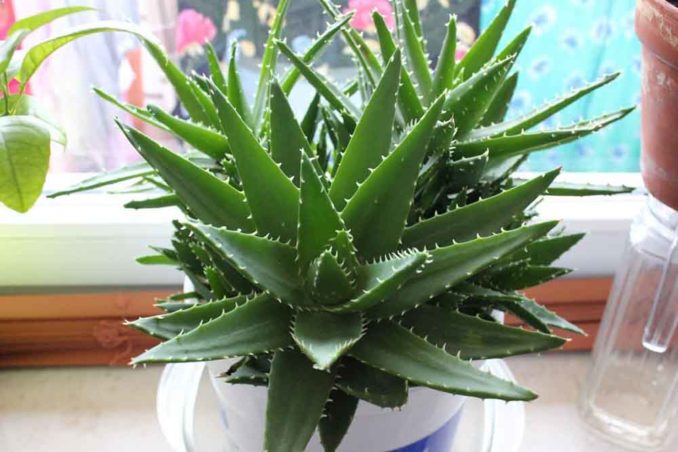
Aloe illumination
Aloe is a light-loving plant, so it is best to grow it at home on the south side of the house, while it is not afraid of direct sunlight on the plant. A bush that has stood in the shade for a long time is gradually taught to the bright rays of the sun. In the winter season, the bush sometimes needs additional lighting, for this you can use fluorescent lamps.
Temperature regime for aloe
During the summer, aloe develops and grows within its normal range at normal room temperature. In the warm season, it can be transferred to fresh air on a balcony, loggia or veranda, while a place protected from precipitation is selected for it. If, in the summertime, you do not transfer the plant to the street, then it is recommended to ventilate the room in which the aloe is located from time to time. In winter, aloe has a dormant period, in this regard, it is recommended to rearrange it in a cool place (no warmer than 14 degrees). If the room is warmer, then the bush can begin to actively stretch out, since in winter the sun cannot give it the required amount of light.
Watering aloe

During the growing season, watering aloe is carried out immediately after the surface of the potting soil dries out. In winter, watering should be more rare, however, the earthen coma should not be allowed to dry out. When moistening the substrate, make sure that no liquid gets inside the leaf outlet, because this can lead to decay of the trunk, and this, in turn, can accordingly destroy the bush.
Aloe bloom

In order for the aloe to bloom, it needs to arrange a period of rest, which is possible only with a long day of light and coolness. It is quite difficult to provide a plant with such similar conditions when growing in an apartment; therefore, its flowering can be seen very rarely.
Aloe fertilizer
Aloe top dressing is carried out from the second half of spring to early autumn with a frequency of 1 time in 4 weeks. When the bush is dormant, it is not necessary to apply fertilizer to the soil mixture.
Aloe transplant

A substrate suitable for growing aloe must consist of sod and deciduous soil, and also sand in a proportion (2: 1: 1). In order for the soil mixture to be looser, it is mixed with a small amount of charcoal and small pieces of brick or crushed stone. The transplant is carried out only if necessary, as a rule, young bushes are subjected to this procedure once every couple of years, and older ones - once every 4 years.








